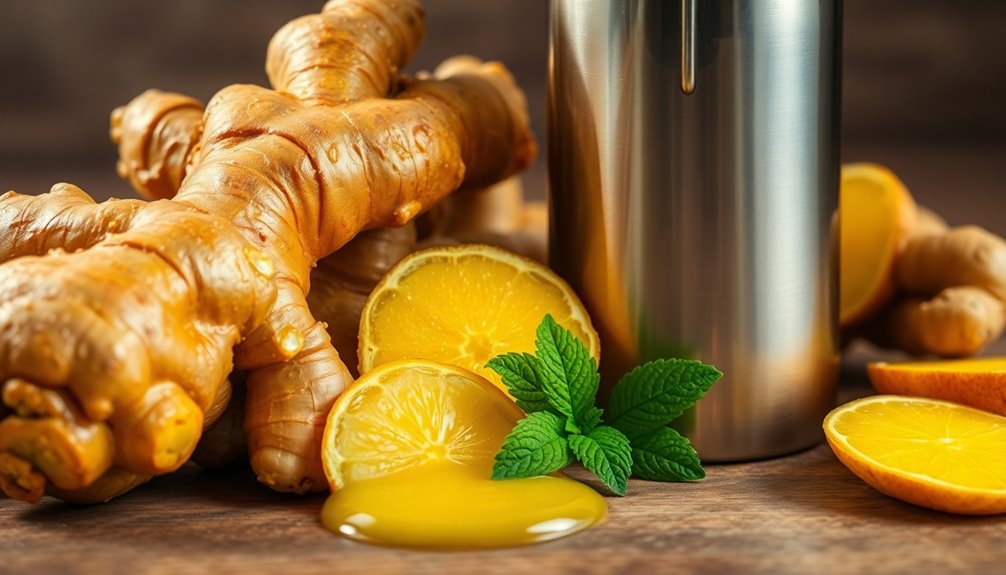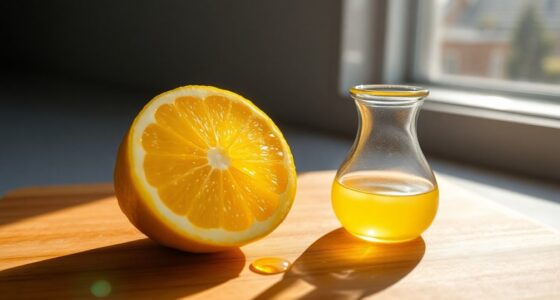To make ginger juice, start by peeling fresh ginger and chopping it into small pieces. Blend the ginger with water in a 2:1 ratio until smooth, then strain the mixture using a fine mesh strainer or cheesecloth. For extra flavor, consider adding lemon juice, maple syrup, or black pepper. Store the juice in the fridge for up to three days or freeze it in ice cube trays for longer preservation. There's even more you can customize for your ginger juice!
Key Takeaways
- Peel and chop fresh ginger roots, then combine with water in a blender at a 2:1 ratio.
- Blend until smooth to extract the juice, then strain the mixture using a fine mesh strainer or cheesecloth.
- Optional: Enhance flavor by adding lemon juice, maple syrup, or black pepper for extra benefits.
- Store ginger juice in the refrigerator for up to three days or freeze in ice cube trays for longer preservation.
- Customize the recipe by adjusting the ginger-to-water ratio and experimenting with different fruits or sweeteners.

Making ginger juice is a simple and refreshing way to enjoy the zesty flavor and health benefits of this powerful root. If you love the kick that fresh ginger brings to various dishes, you're in for a treat. Not only does ginger juice offer a burst of flavor, but it also packs a nutritional punch. You can whip up your own homemade ginger juice easily with just a few ingredients and a blender.
To start, you'll need fresh ginger. Look for firm roots with smooth skin, as these will yield the best flavor. Begin by peeling the ginger, which you can do with a spoon or a vegetable peeler. Once you've got your ginger ready, chop it into smaller pieces to make the blending process easier. The ratio for making ginger juice is about 1 part ginger to 2 parts water, so you can adjust the quantities based on how much juice you want to create.
Next, toss the chopped ginger into a blender along with the water. Blend it well until the mixture is smooth. This is where the magic happens; the blender helps to extract the juice from the ginger. After blending, it's time to strain the mixture to separate the juice from the pulp. You can use a fine mesh strainer or cheesecloth for this step. Pour the blended mixture into the strainer and press down firmly to extract as much liquid as possible. The result is a vibrant ginger juice ready for your enjoyment.
For those looking to elevate their ginger juice, consider mixing in some lemon juice. This not only enhances the flavor but also adds additional health benefits. Lemon juice is known for its vitamin C content and can complement the properties of ginger nicely. If you like a bit of sweetness, you can add a touch of maple syrup. Just a small amount will do, and it balances the spiciness of the ginger. To further boost absorption of the nutrients, try adding a pinch of black pepper. It might sound unusual, but it works wonders!
Once you've created your ginger juice, you can store it in the refrigerator for up to three days. For longer preservation, pour the juice into ice cube trays and freeze it. This way, you can enjoy your homemade ginger juice whenever you want, simply by popping out a cube or two.
Feel free to get creative with your ginger juice recipe. You can experiment with different sweeteners, or even incorporate other fruits and vegetables, like apples or cucumbers, to create a unique flavor profile. Making ginger juice at home allows you to customize it to your taste and health needs, making it a delightful addition to your kitchen routine.
Frequently Asked Questions
How Do You Make Ginger Juice?
To make ginger juice, you'll want to start by peeling and chopping fresh ginger.
Next, blend it with water until it's smooth.
After that, strain the mixture through a fine mesh strainer or cheesecloth to get the juice.
If you prefer a stronger flavor, use less water.
You can also add lemon juice or sweeteners to enhance the taste.
Store any leftover juice in the fridge for up to a week.
Enjoy!
Is It OK to Drink Ginger Juice Everyday?
Drinking ginger juice daily can be safe for most people, with studies showing a daily intake of up to 4 grams of ginger reducing inflammation effectively.
You'll likely enjoy benefits like improved digestion and reduced bloating, but moderation is key.
If you have specific health concerns or are pregnant, it's best to consult a healthcare provider first.
Fresh ginger juice packs the most benefits, so enjoy it while it's at its peak!
How to Make Ginger Drink at Home?
To make a refreshing ginger drink at home, start by peeling fresh ginger and chopping it into small pieces.
Blend the ginger with water until smooth, then strain the mixture through a fine mesh strainer or cheesecloth.
For extra flavor, mix in fresh lemon juice and a sweetener like honey or maple syrup.
If you like, toss in some chia seeds for added texture.
Refrigerate your drink and shake well before serving!
How to Make Fresh Ginger Juice Without a Juicer?
You might think making fresh ginger juice without a juicer is tough, but it’s actually pretty simple! All you need is some fresh ginger, a grater, and a fine mesh strainer or cheesecloth. Simply grate the ginger, then squeeze the pulp through the strainer to extract the juice. If you’re interested in similar homemade remedies, you might want to learn how to prepare garlic juice as well, as it offers numerous health benefits too!
Start by peeling and chopping fresh ginger into small pieces. Blend it with water until smooth, then strain it through a fine mesh strainer or cheesecloth.
Press down to extract as much juice as possible. Store your ginger juice in the fridge for up to a week or freeze it for longer use. Enjoy the fresh flavor!
Conclusion
In conclusion, making ginger juice is simple and rewarding. You can easily unlock its health benefits by following the straightforward steps outlined. Some believe that fresh ginger juice can boost your immune system and aid digestion, and there's truth to that. By incorporating ginger juice into your daily routine, you're not just adding flavor; you're also embracing a natural remedy. So, go ahead and give it a try—you might just discover a new favorite drink that supports your well-being!
Cindy thoroughly researches juicing trends, techniques, and recipes to provide readers with practical advice and inspiration. Her writing style is accessible, engaging, and designed to make complex concepts easy to understand. Cindy’s dedication to promoting the advantages of juicing shines through her work, empowering readers to make positive changes in their lives through the simple act of juicing.

















